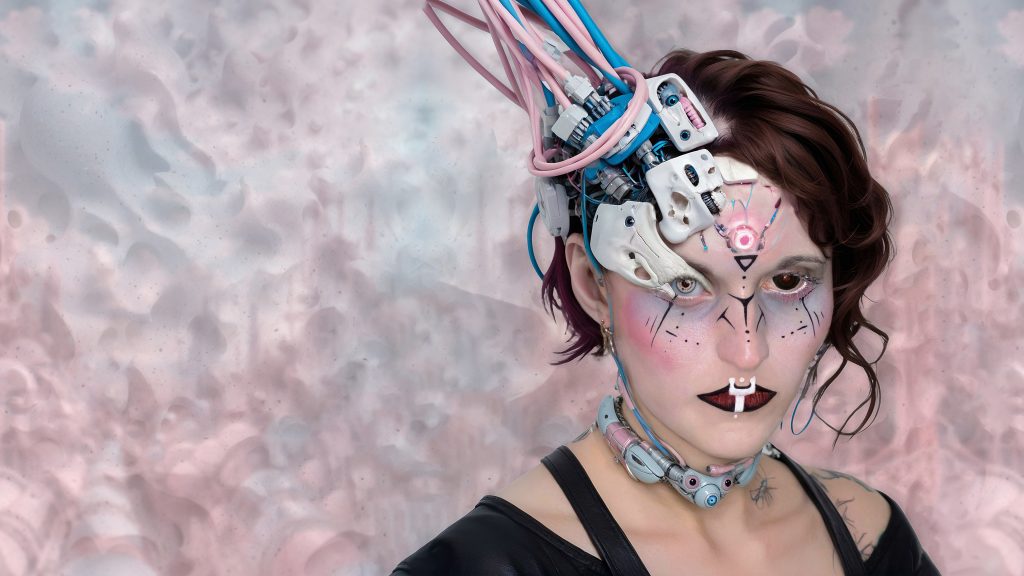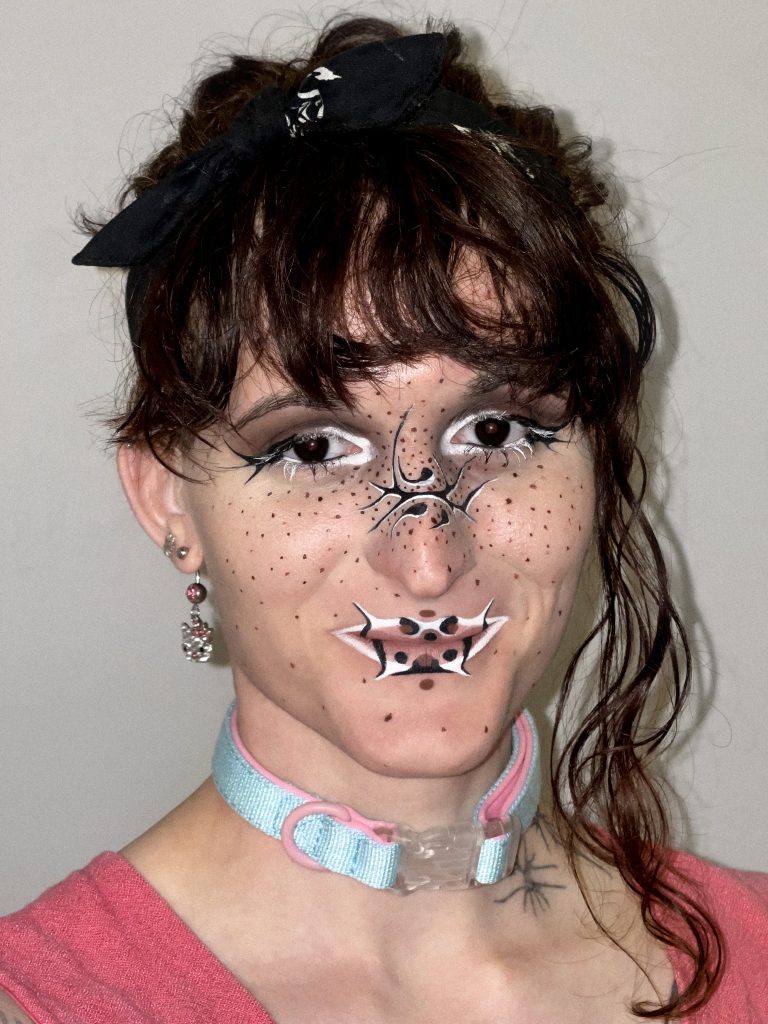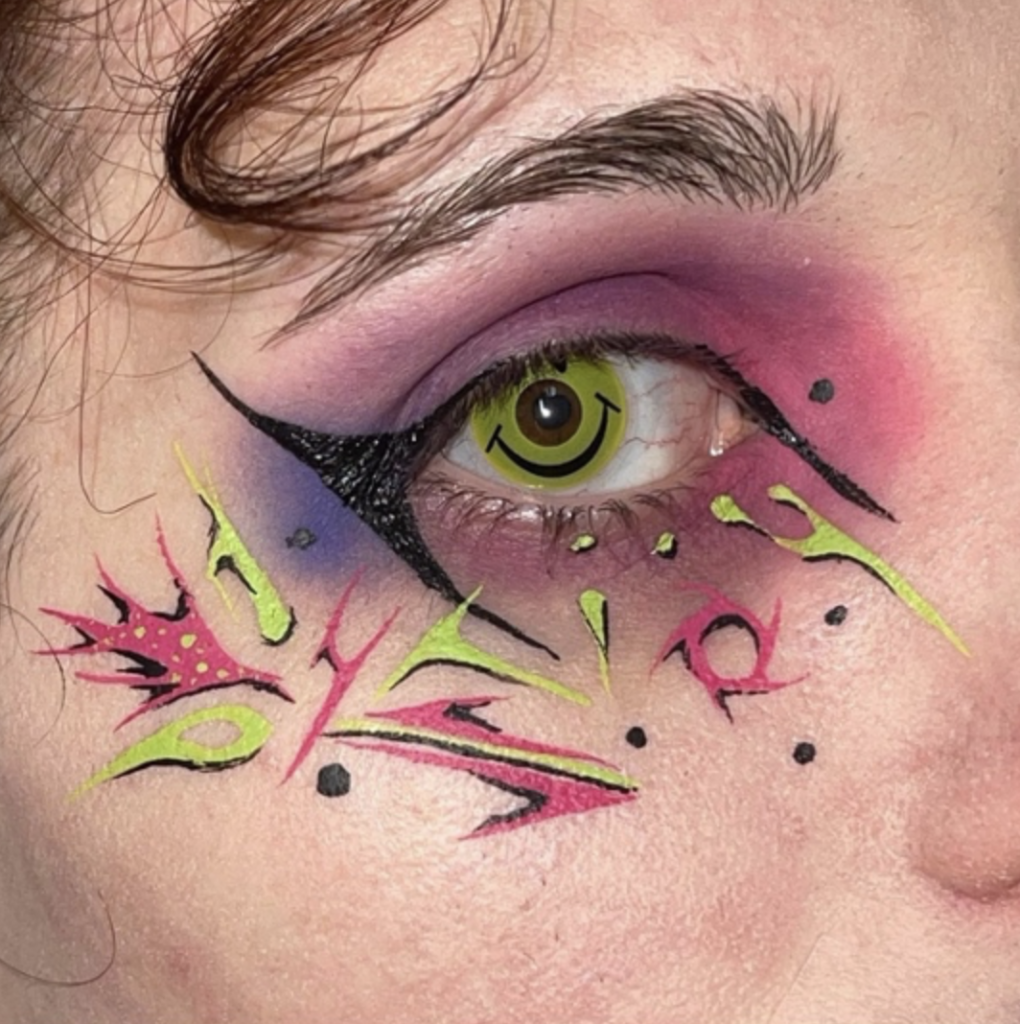This text is a love letter to Isa, to hyperbass, to XF, to the demoscene, and a reminder that life, in all its complex and technologically mediated glory, is a canvas for radical self-creation and empathy.
Isaka Links: Soundcloud Bandcamp Symbios.wiki Instagram Her new EP Elytra drops October 18th on SFX
I first encountered Isaka’s work during a late-night music hunt for my upcoming radio show. A radio station had asked a few DJs to create thematic shows about socio-political topics they cared about, and for me, this has meant exploring (cyber)feminism through sound.
It was around 2 AM, headphones on, digging through the internet when I stumbled upon XENOFEMiNiST ANTiNATURALiST. The track hit me feeling both familiar and alien – it was a standalone piece that embodied the very essence of revolution I was searching for.
In the months that followed, Isa and I found ourselves crossing paths in Berlin multiple times – sometimes by chance(??) and sometimes by design. I also had the luck to catch Isa performing her live A/V live set. It’s through this performance that I’d like to introduce you to Isaka.
As I enter the room, I’m transported into Isa’s world – and a living embodiment of our earlier conversations about technology, identity, and aesthetics. The first half of the performance unfolds as a dreamy fusion of the playback of visuals synchronized with music, while Isa performs her makeup routine live.
Sound Design
When it comes to sound design, Isa’s process entails structuring noise into music using distortion – not as a destructive force though, but rather as a tool for reconstruction. It isn’t about perfect replication but more so about exploring the aesthetics of digital approximation – an uncanny almost-realness of synthesized sound.
Isa: “Noise is how you do it. Noise is how you take something that sounds sterile and made in a computer, and you give it life. You give it the essence of what it means to be put into reality – the messiness of actualization of concepts takes form in noise.”
The boundary between ‘real’ and ‘artificial’ sound is constantly blurred and questioned. But it’s the visuals that accompany these tracks that truly bring our discussions to life – manifested by every pixel and shader. Throughout the next few minutes, I find myself challenging our conventional understanding of performance and creativity.
A typical Isaka kick drum patch:

Isa: “The visuals are calculated in real-time every time to the music. To me, it’s very important to let computers perform for people — and this comes all the way back from the demoscene.”
Visuals & Demoscene
It’s as if the machine itself is improvising, responding to the music creatively without necessarily imitating what humans would do. Who is the performer here? Isa, who wrote the code and composed the music? Or the computer, executing complex calculations to generate and render this visual experience in real time? It’s a loving tribute to a subculture that has been quietly influencing digital art for decades.
Demoscene is a digital world in which programmers compete to create stunning audiovisual experiences with incredibly small file sizes (often up to 4096 bytes only!!). It emerged back in the 1980s, starting as crackers adding introduction screens -signatures – to altered game code to claim credit. Soon enough though, it evolved into a vibrant community competing to push the boundaries of what computers could do.
// Video recording of “Fermi Paradox”, a 64Kbyte real-time short film by Mercury. First presented at the Revision 2016 demoparty, winning 1st place. Download the actual file here (Windows only) //
This all flips the traditional notion of human-computer interaction. It’s about fostering a new kind of relationship between humans and machines – one where we’re collaborators appreciating the distinct capabilities and creativity of our (digital) counterparts.
“Get ready with me”/ Self-engineering
Centre stage sits Isa, calmly applying her makeup.
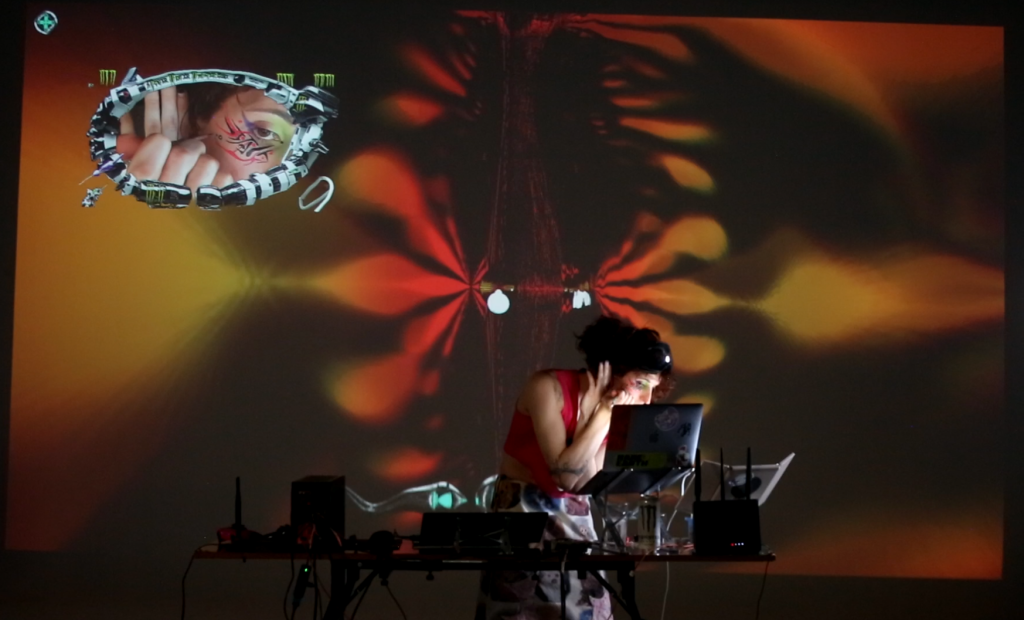
Isa: “I came up with this idea to just do my makeup. I’m doing my makeup all the time – It’s actually funny – a lot of people in Berlin only know me as a makeup artist. And, also, it’s easier to get ready for the show because I know that I’ll do my makeup when I arrive rather than at home. Makeup is also how me and a lot of other trans people, figure out that we’re trans. There’s something about makeup where it’s like you want to disfigure your face. You want to, actually feel like you have control over what your face looks like”
This personal ritual of one’s makeup routine is what makes the whole set deeply intimate. Turns out, the makeup routine has not been part of the original concept, but this rather spontaneous idea turns out to be one of the key elements of the show. Is there even actually a way to exist at all without having aesthetics?
Isa: “[Aesthetics] It’s literally the shape that something takes to exist. You’re always already wearing makeup, right? Humans have kind of genetically engineered ourselves over the course of millions of years to where our bodies are mostly not covered in hair, and we have eyebrows etc. That’s makeup to start with…”
It’s a refusal to pretend that we can exist outside of aesthetics. Even those who claim to reject aesthetics are, in fact, making an aesthetic choice –
“It’s ultimate aesthetics to claim that your aesthetics isn’t aesthetics.”
Recognizing that nothing is truly “natural” about our bodies or identities opens up possibilities for more fluid approaches to self-expression and self-creation.
Makeup then becomes a form of engineering – not just of appearance, but of the self. Really, every choice we make about our bodies – whether conscious or unconscious – is a form of modification or “makeup.” We are not fixed, “natural” beings, but ongoing projects of self-creation.
Datafication & Empathy
We find ourselves in a continuous process of self-engineering, shaping our identities and experiences – in both physical and digital worlds. This hyperreal existence, where the lines between the two spheres, has become our new reality. Self-engineering involves creating different models of ourselves that we can explore, modify, and present to the rest of the world.
The choices we make in digital spaces influence our physical realities, and vice versa. This interplay between the digital and physical aspects of our existence creates a kind of feedback loop of self-engineering – where each side informs and shapes the other. Datafication itself then maybe does not need to be seen as a technological process but as a new way of engaging with and understanding the world around us – including ourselves.
Datafication tends to be described as something artificial and self-alienating – but what if, through it, we can actually see the world more clearly and understand it more deeply? This might seem counterintuitive at first – how can reducing something to data increase our understanding and connection to it?
Isa: “Datafication is a form of empathy. When you try to reconstruct something via a model, it just uncovers a whole new relation that you can have with it.”
Isa illustrates this concept with an example from her work with plant models: “I really like plants. A lot of my work has involved models of plants and stuff, but it wasn’t until I did this project where you could really just pick up a leaf and you can see exactly how it grows, what the leaf is doing, and why it’s doing that.”
Maybe, the key to learning more about our relations with other beings lies in the attempts to capture the world through data. Modeling something digitally can reveal nuances and details that might otherwise go unnoticed.
Isa: “It’s not about perfect replication but more so about exploring the aesthetics of digital approximation – an uncanny almost-realness. But also, in the end, the model never actually works, so you learn about the object through what it isn’t.” This deep engagement with the object through digital modeling allows for a new kind of seeing, a more intimate understanding.
Datafication pushes us to look closer, think deeper, and perhaps, understand more fully. However, there have always been profound questions about the nature of reality and our ability to perceive it. Isa draws on Wittgenstein’s secondary thoughts on his ladder metaphor: “You see it for what it is or not at all.” – suggesting that true comprehension comes as a sudden, holistic realization.
As Isa completes her makeup routine, the performance seamlessly transitions into its second half, where she begins to manipulate both the music and the visuals live. Isa takes her place behind a setup of controllers and computers, her freshly made-up face illuminated by the glow of the screens.
Isa: “The second half of the show is a touch designer live-coding-inspired thing where it’s also shader-based. There’s no video art going on, it’s just me playing with some shaders and some visualizers with a controller – and doing an Ableton live set. The makeup and the demoscene act as a thesis/antithesis of the performance. In the end, they are inseparable and there isn’t really a thesis and an antithesis – they are a dipole, either could be either. The final half of the show is the synthesis.”
The room pulses with sound and light. As I am leaving the venue a few hours later, I feel that I’ve experienced a fundamental redefining of what it means to be a person in our increasingly complex world. In blurring the lines between human and machine, between physical and digital, Isa invites us all to imagine new ways of being, new forms of identity and expression that transcend traditional boundaries. Embracing the alien and the artificial as pathways to a more inclusive and liberated future. “This is the way of liberating dehumanized people.”
We are constantly being subjected to technology – from the food we eat to the digital worlds we live in – and it is difficult to imagine getting rid of it. Isa demonstrates how we can instead harness technology and turn tools of potential oppression into instruments of liberation. By embracing our ‘otherness’ and the alien aspects of our technologically mediated existence, we can reshape the narrative. Tying back to XF and cyberfeminism, technology can be a means of empowering marginalized voices to redefine the very structures that once sought to confine them. Maybe technology can help create a space for all forms of existence and expression, where freedom can be achieved through embracing the artificial, and community through shared alienation. We are always already alienated.
Isa inspires us to think about the intersections of our own experiences and encourages us to stitch together new, more inclusive narratives for who we can become. In this liminal space, Isa suggests a new way forward: to engineer our worlds with empathy.
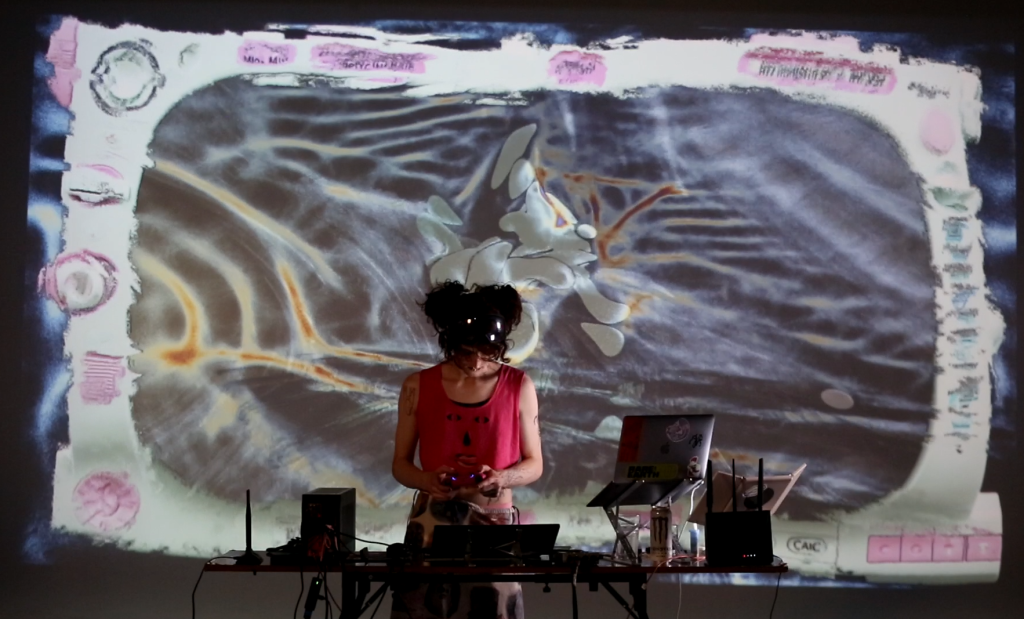
—
Pure Anna is a digital ethicist, curator, and DJ based in Amsterdam. In her research, she is interested in rhizomatic thought, cyberfeminism, and the interaction of sound and digital spaces.


